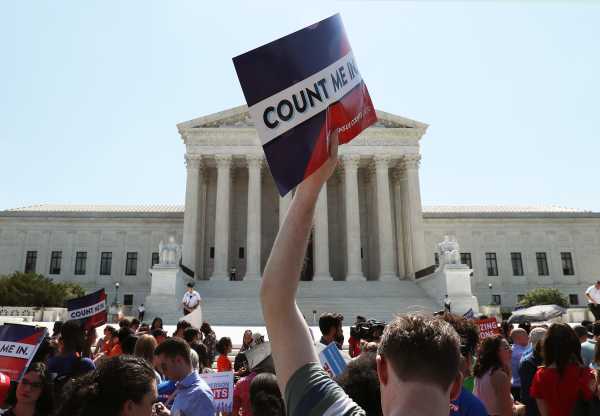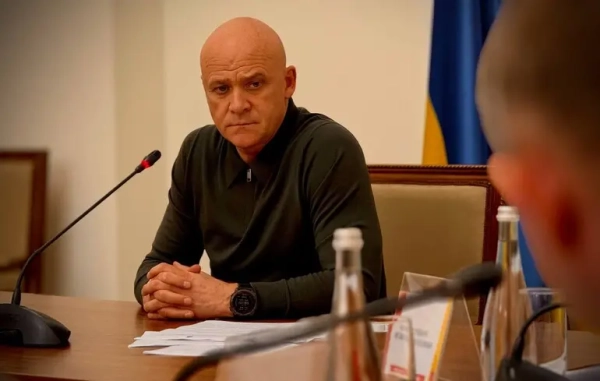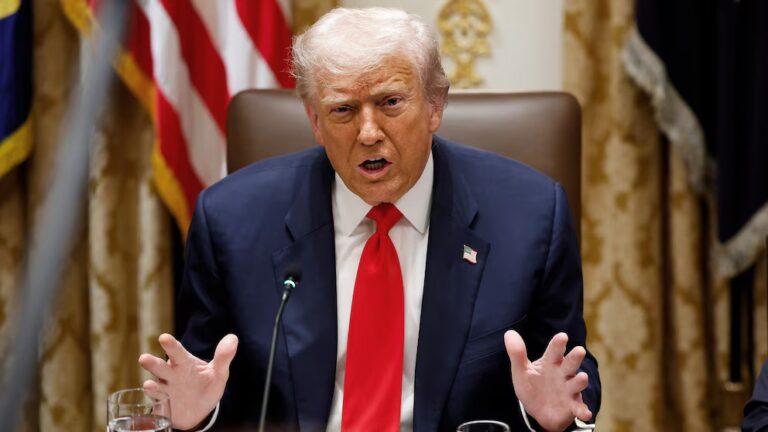
The opening brief in Moore v. Harper, an extraordinarily high-stakes election case that the Supreme Court will hear December 7, is one of the least persuasive documents that I’ve ever read in any context. And I’ve read both Ayn Rand’s Atlas Shrugged, and Donald Trump’s Art of the Deal.
Moore is also potentially the biggest threat to free and fair elections in the United States to reach the Supreme Court in my lifetime — and I was alive for Bush v. Gore. Four justices have endorsed the utterly nonsensical legal theory underlying Moore, which means that, unless one of those four has second thoughts, the future of US elections will be decided by Trump-appointed Justice Amy Coney Barrett.
To be fair, enough conservative elites have now denounced this lawsuit that there is a real chance some of their ideological allies on the Court will have second thoughts. But the fact that any judge might embrace this nonsensical legal theory is absurd.
The case involves the awkwardly named “independent state legislature doctrine” (ISLD), a theory that the Supreme Court rejected many times over the course of more than a century. It’s also a theory repudiated by many of the very same sources that the ISLD proponents rely upon in their briefs to the justices.
Under the strongest form of this doctrine, members of each state’s legislative branch have unchecked authority to decide how elections for Congress and the presidency will be conducted in their state — indeed, a state legislature could potentially pass a law canceling the presidential election in that state and awarding its electoral votes to Donald Trump. Any state constitutional provisions that protect the right to vote, that limit gerrymandering, or that otherwise constrain lawmakers’ ability to skew elections would cease to function. State governors would lose their ability to veto laws impacting federal elections. And state courts would lose their authority to strike down these laws.
As Justice Neil Gorsuch wrote in a 2020 concurring opinion endorsing the ISLD, “the Constitution provides that state legislatures — not federal judges, not state judges, not state governors, not other state officials — bear primary responsibility for setting election rules.” Notably, this opinion was joined by Justice Brett Kavanaugh, who currently sits at the conservative Supreme Court’s ideological center.
In fairness, the petitioners in Moore (in Supreme Court parlance, the term “petitioner” typically refers to the party that lost in the court below) take a slightly less extreme position than Gorsuch and Kavanaugh. For example, these petitioners, Republican lawmakers in North Carolina who object to a state supreme court decision striking down gerrymandered congressional maps, do not ask the Court to overrule Smiley v. Holm (1932), which held that state governors may exercise their veto power over election legislation.
But the Moore petitioners nonetheless seek sweeping and radical changes to some of the most foundational principles of US election law. They argue that state constitutions “may not impose substantive state-constitutional limits” on laws governing federal elections, an argument that also precludes state courts from striking down election laws that violate such limits. In practice, their theory would also make the Supreme Court, where Republican appointees control two-thirds of the seats, the final word on disputes arising under state election law (currently, state supreme courts have the final say on all questions of state law).
An array of conservative luminaries filed briefs practically begging the Supreme Court not to do any of this. Foremost among them is J. Michael Luttig, a former federal judge who was on the cutting edge of legal conservatism in the Clinton and George W. Bush administrations.
Then there’s an amicus brief signed by Steven Calabresi, a founder of the conservative Federalist Society and the co-chair of its board, warning that the Moore petitioners “flout core tenets of the American Founding.” A brief by Benjamin Ginsberg, for many years the Republican Party’s top election lawyer, warns that the ISLD would “create untenable legal uncertainty around elections” and “increase the odds that state legislatures replace the popular vote with their own political preferences.” A brief on behalf of retired admirals, generals, and service secretaries — some of whom held high-level political appointments in Republican administrations — warns that the ISLD “undermines election integrity and exacerbates both domestic and foreign threats to national security.”
Let me be explicit about just how weak the arguments are supporting the independent state legislature doctrine: Any judge who, after reading the briefs in this case, concludes that the ISLD has merit is either too incompetent to practice law or too blinded by ideology to sit on any court.
This entire case turns on the Moore petitioners’ inability to understand a dictionary
The ISLD is one of those legal arguments that, if I can borrow some choice words from the late Justice Antonin Scalia, periodically rises “like some ghoul in a late night horror movie that repeatedly sits up in its grave and shuffles abroad, after being repeatedly killed and buried.”
The Court first rejected it in Davis v. Hildebrant (1916), which upheld a provision of the Ohio constitution permitting the people of the state to veto state election laws via a popular referendum — even though that meant blocking a law enacted by the state’s legislative branch. It rejected the ISLD again in Smiley, the 1932 case holding that governors may veto election laws. The Court most recently rejected it in Arizona State Legislature v. Arizona Independent Redistricting Commission (2015), which held that states may use a bipartisan commission to draw congressional maps.
It’s likely that this particular ghoul refuses to die because the independent state legislature doctrine actually sounds plausible if you read the text of the Constitution without doing any legal or historical research, or even bothering to pick up a dictionary to see how a particularly important word is defined.
The Constitution states that “the times, places and manner of holding elections for Senators and Representatives, shall be prescribed in each state by the legislature thereof.” Meanwhile, another provision says that presidential elections shall also be conducted in a way determined by the state “Legislature.”
So the argument for the ISLD is deceptively simple, and can be summarized in three sentences: The Constitution says that the rules governing federal elections shall be made by each state’s “legislature.” A governor, a state supreme court, or a state constitution is not the “legislature.” Checkmate, libs.
The problem with this argument is that, at least at the time when the Constitution was drafted, and popularly elected legislative bodies like the US Congress were a relatively new innovation, the word “legislature” did not mean “the elected body of men and women who make up the House and Senate.” It meant, as the Supreme Court explained in Arizona State Legislature, “the power that makes laws.”
And that power can be shared. Just as the US president plays a role in making federal laws through their veto power, so too can states allocate that legislative power among their various branches of government. Davis confirmed that this lawmaking power may be given, in part, to the people of the state as a whole through a referendum process. Smiley confirmed that a portion of the legislative power may be wielded by a state governor through his or her veto power. Arizona State Legislature confirmed that a portion of this power may be given to a bipartisan commission.
Indeed, if you doubt this definition of the word “legislature,” I encourage you to read the Moore petitioners’ brief. Specifically, I encourage you to read page 14 of their brief, where they quote four dictionary definitions of the word “legislature.”
Only one of these four definitions, from a dictionary published four decades after the Constitution was drafted, even plausibly could be read to support the ISLD. That 1828 dictionary defines the word “legislature” to mean “the body of men in a state or kingdom, invested with power to make and repeal laws.” Notably, even this definition does not state that these men must serve in a formally organized legislative branch. And the other three dictionaries quoted by the Moore petitioners define the word “legislature” the same way it was defined in Arizona State Legislature.
One 1755 dictionary defines the word to mean “the power that makes laws.” Another, from 1797, offers an identical definition. A third, from 1763, defines the word to mean “the Authority of making Laws, or Power which makes them.”
This, alone, is fatal to the Moore petitioners’ arguments — and to Gorsuch and Kavanaugh’s. Properly understood, the federal constitution does not give primacy to a state’s House and Senate. Rather, it says that state election laws should be enacted through whatever process the state uses to make any other law. That may involve a gubernatorial veto, a popular referendum, or a constitutional amendment process that writes some of a state’s election laws into its constitution. A state could even give a portion of its lawmaking power to its judiciary, if it chose to do so.
There is no merit whatsoever to the Moore petitioners’ arguments.
The Moore petitioners’ arguments fail even if you accept the ISLD as valid
Again, the Moore petitioners claim that the Constitution gives North Carolina’s legislative branch primacy in redistricting, and that the North Carolina General Assembly’s decision to draw gerrymandered maps cannot be second-guessed by the state’s courts.
But even if you accept the strongest version of the ISLD — that is, even if you believe that the General Assembly has unchecked authority to decide how congressional districts are drawn in that state — the petitioners should still lose their case. That’s because the General Assembly passed a law which explicitly authorizes certain state courts to hear redistricting lawsuits.
North Carolina law provides that lawsuits challenging “any act of the General Assembly that apportions or redistricts State legislative or congressional districts” may be filed “in the Superior Court of Wake County and shall be heard and determined by a three‑judge panel.” This court’s decision may then be appealed to the state supreme court.
What’s more, North Carolina law — law that was enacted by the legislative branch — provides detailed instructions on how state courts should behave when they determine that a legislative map is illegal. One statute requires state courts to “find with specificity all facts supporting” its conclusion that a map is illegal. Another provides that, after a state court strikes down a redistricting plan, it may not “impose its own substitute plan unless the court first gives the General Assembly a period of time to remedy any defects identified by the court.”
So even if you accept Gorsuch’s extreme version of the ISLD, the Moore petitioners still lose their case. The legislative branch of North Carolina’s government explicitly authorized the state courts to hear lawsuits challenging gerrymandered maps. It gave them specific instructions on how to decide these cases, and it even delineated the specific circumstances when a state court may draw its own maps replacing those drawn by state lawmakers.
The ISLD would transfer an enormous amount of power over elections to a GOP-controlled Supreme Court
Setting aside Moore itself, and the dispute over redistricting commissions in Arizona State Legislature, the independent state legislature doctrine has shambled out of its grave at least two other times in the last three decades. Both times, it was invoked by Republican-appointed justices to solve a political problem: The Supreme Court isn’t supposed to decide most questions involving election disputes, and often the body that is supposed to decide those questions resolves them in ways that favor Democrats.
Consider Bush v. Gore (2000), the dispute over a recount of Florida’s presidential ballots, where the Court split along ideological lines and handed the presidency to George W. Bush.
The case involved several fights over which votes should be counted during a recount of Florida’s presidential ballots, as well as questions about whether this recount had to comply with tight deadlines. The Florida Supreme Court, which was dominated by Democratic appointees in 2000, had resolved many of these questions in ways that favored Democratic candidate Al Gore.
That created a serious problem for Bush. Although the Supreme Court has the final say on questions involving federal law, the Florida Supreme Court had ruled in favor of Gore by interpreting Florida’s own law. And, as the Supreme Court explained in Hortonville District v. Hortonville Education Association (1976), even the nation’s highest Court is “bound to accept the interpretation of [state] law by the highest court of the State.”
Enter the independent state legislature doctrine. Although a majority of the Court did not rely on the ISLD in Bush, Chief Justice William Rehnquist wrote a concurring opinion, joined by two other justices, which argued that the ISLD allows the Supreme Court to bypass the rule prohibiting it from reinterpreting a state’s law — and to substitute its own interpretation of a state election law for that of a state’s highest court.
Pointing to constitutional language stating that presidential electors shall be appointed “in such Manner as the Legislature thereof may direct,” Rehnquist wrote that “in order to determine whether a state court has infringed upon the legislature’s authority, we necessarily must examine the law of the State as it existed prior to the action of the” Florida Supreme Court.
A similar dispute arose during the 2020 election, in Republican Party of Pennsylvania v. Boockvar (2020). In that case, the Pennsylvania Supreme Court ruled that certain mailed ballots, which arrived up to three days after Election Day, should be counted. Because the state supreme court relied upon the state’s own constitution in reaching this decision, it should have had the final word. Again, the US Supreme Court is not allowed to overrule a state’s highest court’s interpretation of the state’s own law.
The full Court decided not to hear the case. But Justice Samuel Alito, in an opinion joined by Justices Clarence Thomas and Gorsuch (but not Kavanaugh), called for the Court to invoke the ISLD to give itself the final word on how to read Pennsylvania’s law. “The provisions of the Federal Constitution conferring on state legislatures, not state courts, the authority to make rules governing federal elections would be meaningless,” Alito claimed, “if a state court could override the rules adopted by the legislature simply by claiming that a state constitutional provision” invalidates those rules.
To be clear, the longstanding rule that state supreme courts, and not the US Supreme Court, have the final say over how to interpret state law will sometimes lead to results that one party thinks are unfair. Currently, for example, the Wisconsin Supreme Court is controlled by Republicans, while Michigan’s Supreme Court has a Democratic majority. That means that Wisconsin’s justices may interpret the state’s election law in ways that benefit Republicans, while Michigan’s justices may interpret it in ways that benefit Democrats.
But the alternative — the one floated by Rehnquist in Bush and by Alito in Republican Party — is much worse. That alternative is to give the US Supreme Court final authority over all disputes involving federal elections, regardless of where that dispute arises, because it would become the final arbiter over whether one side in a dispute infringed on the state legislature’s power. It would mean that, no matter what, the outcome of a disputed congressional or presidential election would rest on a Court where Republican appointees currently have a 6-3 supermajority.
The ISLD would effectively turn Brett Kavanaugh, the median vote on the current Supreme Court, into the final authority on all federal elections.
No Court that would claim this kind of power can be trusted with it
The independent state legislature doctrine is obviously and embarrassingly wrong. It relies on a simplistic reading on the Constitution that is repudiated by many of the same sources quoted in the Moore petitioners’ briefs. It would upend more than a century of precedent. And it would give an unprecedented amount of power over elections to whichever political party controls the Supreme Court.
Indeed, the arguments for the independent state legislature doctrine are so flimsy, and the consequences of a Supreme Court decision embracing it are so alarming, that even the co-chair of the Federalist Society’s board — the same Federalist Society that Trump relied upon to choose his judges and justices — is urging the Supreme Court to stay its hand. I am under no illusions that the pivotal justices on this Court will care what I have to say about Moore, but I hope they can find it within themselves to listen to Steven Calabresi. Or to Judge Luttig. Or to the generals and admirals telling them that the ISLD is a threat to national security!
And, on top of all of that, the Moore petitioners have managed to bring a case to the Supreme Court that is so weak that they should lose even if you accept their ludicrous reading of the Constitution.
Any justice who would claim the simply enormous amount of power offered to them by the independent state legislature doctrine cannot be trusted to wield that power fairly, or in a nonpartisan way. There is simply no plausible legal argument for the ISLD, and so a Supreme Court decision embracing it would be a declaration that the law simply does not matter in this Court.
And it would be a declaration that every disputed federal election will now be resolved by justices who care nothing about the law.
Sourse: vox.com






